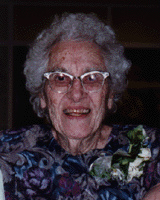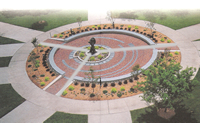
Anna Mae Bradshaw
is honored with a Brick from Mrs. Katharine H. Knorr.
 Anna Mae Bradshaw was born in Burns, Kansas, January 18, 1901, in a parsonage to Lillie and Reverend Allen Burrill. Even as a little girl, she was fascinated with design and form in nature, and loved drawing pictures. When frost collected on the window panes, she sketched little snow scenes with her fingernails.
Anna Mae Bradshaw was born in Burns, Kansas, January 18, 1901, in a parsonage to Lillie and Reverend Allen Burrill. Even as a little girl, she was fascinated with design and form in nature, and loved drawing pictures. When frost collected on the window panes, she sketched little snow scenes with her fingernails.
At Pittsburg State College in Kansas, she began her study of art in 1921, and later married her high school teacher. Six years later, a son was born. Along with motherhood, she began doing all kinds of art work, such as ceramics, charcoal drawings, water color paintings, etc. When the Depression began in 1929, Anna Mae started teaching to supplement her husband's salary as a school principal, which was only $2,000 a year.
Beginning in 1929, she went to California for summer vacations. During this time, she studied with Henry L. Reichter, graduate of the Munich Academy, for private lessons and field trips up and down the coast of California. In 1944, the Bradshaws moved to California, where Anna Mae began four years of study with art teachers at the Choinard School of Art in Los Angeles. Areas of study included watercolors with Loren Barton and Rex Brandt (National Academy of Munich) and life drawing with Ben Messick. She also studied marine painting with Arthur Beaumont, graduate of the Royal Academy of London, and anatomy for portraiture from Karl Seethaler, who graduated from the Academy of Art in Vienna. In 1947, she studied at Long Beach City College. She also served on the Long Beach Art Association Board. In New Mexico in 1933, she met E. Martin Hennings, one of the original six Taos painters, and went to his home and studio.
In Wichita, Anna Mae has taught, painted and lectured in the field of art for the past 50 years. In 1937, she was appointed Grand Chaplain of the Grand Chapter of Kansas Order of Eastern Star (86,000 members). In 1941, she was honored with their highest office Worthy Grand Matron of Eastern Star.
Traveling took her to Europe in 1980, where she sketched and painted in eight countries. While in the Louvre and Reich Museums, she was commenting about the art to fellow tour members, and soon crowds began to gather, thinking that she was a member of the staff. She commented, with a twinkle in her eye, "I never passed the tin cup."
In the Wichita art scene, Anna Mae has had many outstanding leadership roles She served on the Wichita Art Museum Board and, for four years, she served as the state art chairman of the Kansas Federation of Women's Clubs. Anna Mae is past president of the Artists Guild of Wichita and also of Wichita Women Artists. She is a charter member of the Kansas Watercolor Society and National Women in the Arts, Washington, D.C. She wrote the "Art News" in the Wichita Beacon and Eagle in the 1950s.
Hanging in the Kansas Masonic home are her five paintings, "Women of the Bible," each measuring 8 feet by 4 feet. These paintings were printed in an English Bible in 1944. Her war painting, "Prayer for Peace," pictures the last battle of World War I in the Argonne Forest. It was painted from a descriptive narrative of her husband, who was on the front for 100 days without relief. He served in the 89th Division of the U.S. Army.
Anna Mae's paintings have been exhibited and earned awards in national and state-juried exhibitions. For 50 years, she has been a member of the National League of American Pen Women, serving twice as president of the Wichita branch. Her "Christian Symbolism" oil painting is displayed at the East Heights United Methodist Church. A 40 foot by 20 foot mural is owned by a Shrine Mosque in Pittsburg, Kansas. She also has completed five baptismal church murals.
In the 1950s, when the Wichita Art Museum was under the direction of the University of Wichita, President Corbin appointed Anna Mae as a member of the board of directors, where she also lectured for four years.
As a teacher, Anna Mae's deepest conviction is "If a work of art is not created in your mind, it is not a work of art." She teaches creative art and never copy work. "Learn the color wheel, learn design, and learn the rules of composition. Nature is God's art. We paint according to the rules of fine-art design, composition, color and texture. We repeat the color. We place our point of interest in the middle third." Her students often hear her say, "All in art is light and dark, every painting has a life of its own, and simplicity is the soul of all art."
In conclusion, not only has Anna Mae written volumes about art, she has painted landscapes, portraits, still life, nature and marine paintings, snow scenes, night scenes, historical settings, and captured virtually all types of situations. Her students remember their beloved teacher and friend by her unending kindness, her encouraging words and her brilliant talent.
July 22, 1998










